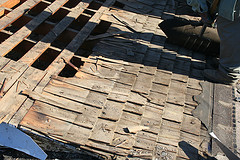Asphalt Shingle Recycling Facts and Figures
 Do you know which is the most commonly used type of roofing shingle? If you said "asphalt," you're correct; these shingles are used for about 80 percent of roofs in the US today. Despite this figure, until quite recently the standard advice on disposing of used asphalt shingles following a roof replacement was "transport them to the nearest landfill." However, in recent years, asphalt shingle recycling centers have been opening in major towns and cities throughout the United States. Why are these facilities so important and what actually happens to the shingles after you remove your roof?
Do you know which is the most commonly used type of roofing shingle? If you said "asphalt," you're correct; these shingles are used for about 80 percent of roofs in the US today. Despite this figure, until quite recently the standard advice on disposing of used asphalt shingles following a roof replacement was "transport them to the nearest landfill." However, in recent years, asphalt shingle recycling centers have been opening in major towns and cities throughout the United States. Why are these facilities so important and what actually happens to the shingles after you remove your roof?
Why Recycle Asphalt Shingles
The average residential roof removal generates 1-3 tons of asphalt shingles, depending on whether the old roof consisted of 1 or 2 layers. All this adds up to an estimated total of 10 million tons of torn-off shingles every year nationwide, plus another 1 million tons of scrap generated by the shingle manufacturing process. This is a huge amount of waste to add to our already overcrowded landfills, especially since shingles take approximately 300 years to break down. (In fact, some states have legislation banning the disposal of asphalt shingles in landfill facilities.)
Asphalt shingles cannot be composted. Burning the used shingles is not the answer either, because asphalt is manufactured from refined petroleum and its incineration results in the emission of gases hazardous to human health. By contrast, recycling asphalt roofing after removal reduces our country's dependence on a costly, non-renewable resource -- oil. Every ton of asphalt shingles that is recycled reduces the need for oil by 2 barrels.
How Shingles Are Recycled
When your roofing contractor removes the old asphalt shingles covering your home, he will set up a construction trash bin next to the house. As the individual shingles are pried off, they'll slide down into the bin. After your roof removal is complete, the non-asphalt substances will have to be sorted out, either by the contractor onsite or after the load's been hauled to the recyclers. (Nails can be left in place, though. They're extracted at the recycling facility with the aid of super-strong rotating magnets. In some cases, it's permissible to leave wood scraps in the mix as well; these will be separated by flotation.) The recycling service may be free, or there might be a nominal charge, usually less than the cost of dumping the materials in a landfill.
The recycling facility will then proceed to grind the shingles into specific-sized pieces ranging from 1/4" to 3", depending on how they will eventually be used. They may need to go through a sieving process as well, according to their intended purpose.
Where the Shingles Eventually End Up
- The Number One destination for recycled asphalt shingles is in roads, as paving material, aggregate base, or sub-base. However, many local governments have not approved their use for resurfacing public roadways.
- They are also used commercially as patching material on roads, ramps, bridges, parking lots, and sidewalks. Residential applications include patching for private roads, driveways, and paths.
- Recycled asphalt shingles may be turned into ground cover.
- They can be utilized to create new asphalt shingles for roofing purposes.
- Shingles might be broken down to produce fuel oil.
- Ground-up shingles can play a role in controlling dust and erosion at construction sites or on unpaved roads.
Laura Firszt writes for networx.com.
Updated March 4, 2018.
Looking for a Pro? Call us (866) 441-6648

Roofing Average Costs
Roofers Experiences

Seamless Extension Of Concrete Patio And Poolside Retaining Wall

Landscaping Turns A Weed Patch Into A Great Little Zen Garden



